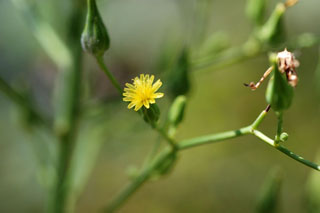WILD LETTUCE
|
 |
| File Size: 33 KB |
|
|
|
Lactuca canadensis L.
|
| Wildcat Glades Conservation & Audubon Center, Newton County, Missouri |
| Biennial |
| Height: 20-120+ inches |
| Family: Asteraceae - Sunflower Family |
| Flowering Period: July, August, September |
|
| Also Called: | | Canada wild lettuce, tall lettuce. | | Stems: | | Erect, solitary, multi-branched above, glabrous or rarely coarsely-hairy, somewhat waxy, often purple-spotted; latex brown. | | Leaves: | | Alternate, highly variable, sessile; basal and lower stem leaves sickle-shaped to linear-ovate or egg-shaped, 6 to 14 inches long, 1.6 to 5.6 inch wide; margins weakly toothed or pinnately-cleft to deeply pinnate-lobed; lower midrib often stiff-hairy; middle and upper stem leaves linear-ovate, egg-shaped, or lanceolate, 4 to 12 inches long; margins entire or toothed to pinnate-lobed; lower midrib glabrous; upper leaves gradually reduced. | | Inflorescences: | | Panicle, much-branched, diffuse, cone-shaped, terminal; heads 50-100+, small, cylindric, less than 1/2 inch across, 1/3 to 1/2 inch tall; bracts 17, overlapping, about 1/3 inch long at flowering and 1/2 inch long in fruit, usually bent downward in fruit; outer bracts lanceolate, inner bracts linear. | | Flowers: | | Ray florets 15-22, about 1/6 inch long, yellow, pinkish-orange, or reddish apex and yellow base; anthers yellow, protruding; disk florets absent. | | Fruits: | | Achene, elliptic or oblong, flattened, 1/5 to 1/4 inch long (including thread-like beak), 1/12 inch wide, dark brown, prominent lateral wings, single rib on upper and lower surfaces, tipped with white bristles 1/5 to 1/4 inch long. | | Habitat: | | Woodland margins and clearings, stream and river banks, rocky open woods, waste places, roadsides, margins of lakes and ponds, thickets, marshes, pastures, borders of fields, disturbed sites; moist, sandy soils. | | Distribution: | | Principally in the east 1/2 of Kansas. | | Origin: | | Native | | Toxicity: | | When grazed, the plant can cause milk to be tainted. | | Uses: | | Native Americans would steep the roots and bark and take the tea for back and kidney pains; took a tea to induce sleep; applied a poultice of pulverized roots to stop bleeding cuts; and used the milky latex to treat poison ivy sores. The leaves were cooked and eaten as greens. |
|
| Wild lettuce |  | | 25 KB | | Wildcat Glades Conservation & Audubon Center, Newton County, Missouri |
| | Wild lettuce inflorescence |  | | 106 KB | | Wildcat Glades Conservation & Audubon Center, Newton County, Missouri |
| | Wild lettuce latex |  | | 29 KB | | Wildcat Glades Conservation & Audubon Center, Newton County, Missouri |
| | Wild lettuce upper leaf |  | | 49 KB | | Wildcat Glades Conservation & Audubon Center, Newton County, Missouri |
| | Wild lettuce mid-stem leaf |  | | 61 KB | | Wildcat Glades Conservation & Audubon Center, Newton County, Missouri |
| | Wild lettuce leaves |  | | 115 KB | | Wildcat Glades Conservation & Audubon Center, Newton County, Missouri |
| | Wild lettuce achenes |  | | 41 KB | | Wildcat Glades Conservation & Audubon Center, Newton County, Missouri |
| | | |
|
|
|
|
|
|